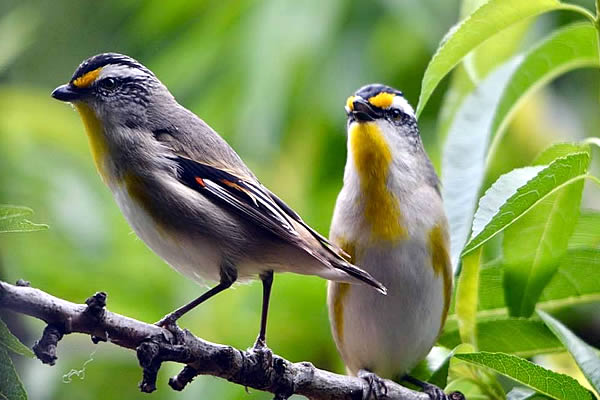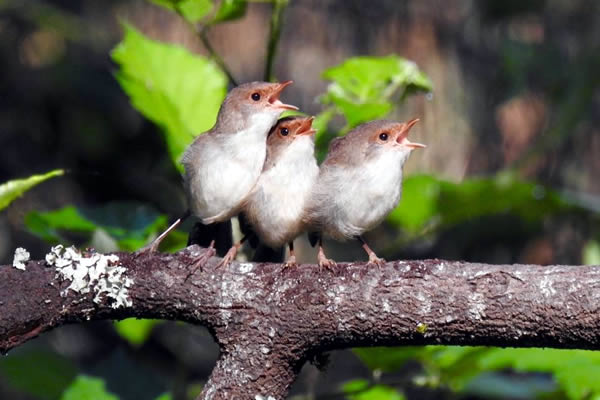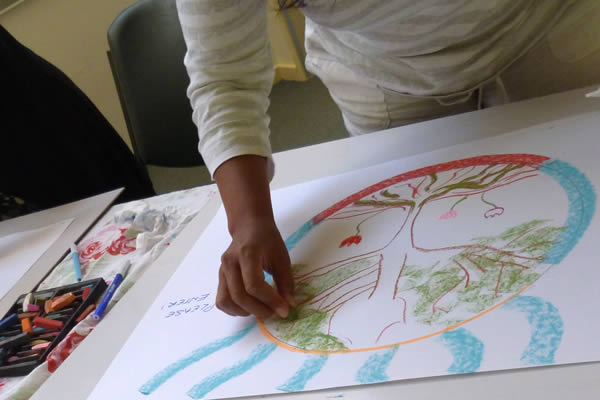These posts explore the lens of building ‘connection’ as a model to guide cultural transformation for teams and organisations.
In Part 1 of this series, I explored the first cornerstone of connection, ‘Connect to Me’. In this post we will look at the second cornerstone, ‘Connect to Us’.
Where ‘Connect to Me’ was all about personal leadership and having the confidence to bring ‘more of who you really are to work’, ‘Connect to Us’ is about the group. It follows that the more each of us is willing to reveal our ‘warts and all’ self at work, (and there is the leadership and team culture that provides the best conditions for this to happen), then the better we will all understand each other. This connection brings healthier ways of working straight back to the workplace. This in turn creates the right conditions for the pursuit of a truly human organisation.
As I mentioned last time, in much of my work in recent years I have used the model presented here – which is adapted from the Barrett Values Centre ‘Get Connected’ model – as a road map to simplify some of the complexity and the multi-faceted considerations that exist when navigating cultural change.
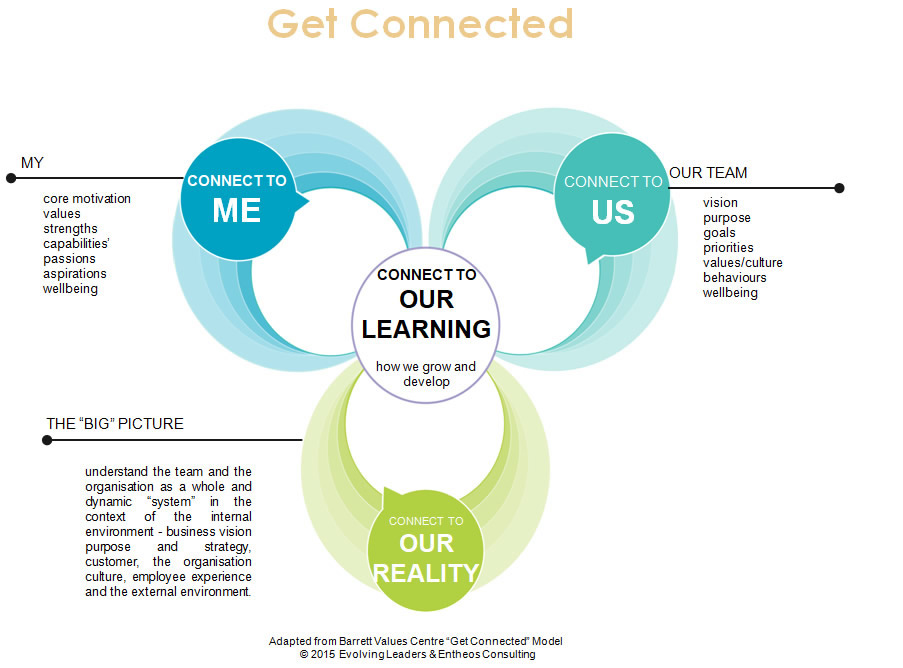
One of the diagnostic models I like to use when working with teams is the Barrett Small Group Culture and Values Assessment.
It asks three simple questions of each member of the team and elicits rich data about what is important to each member of the group personally, how they currently experience the team culture and where they would like that culture to be.
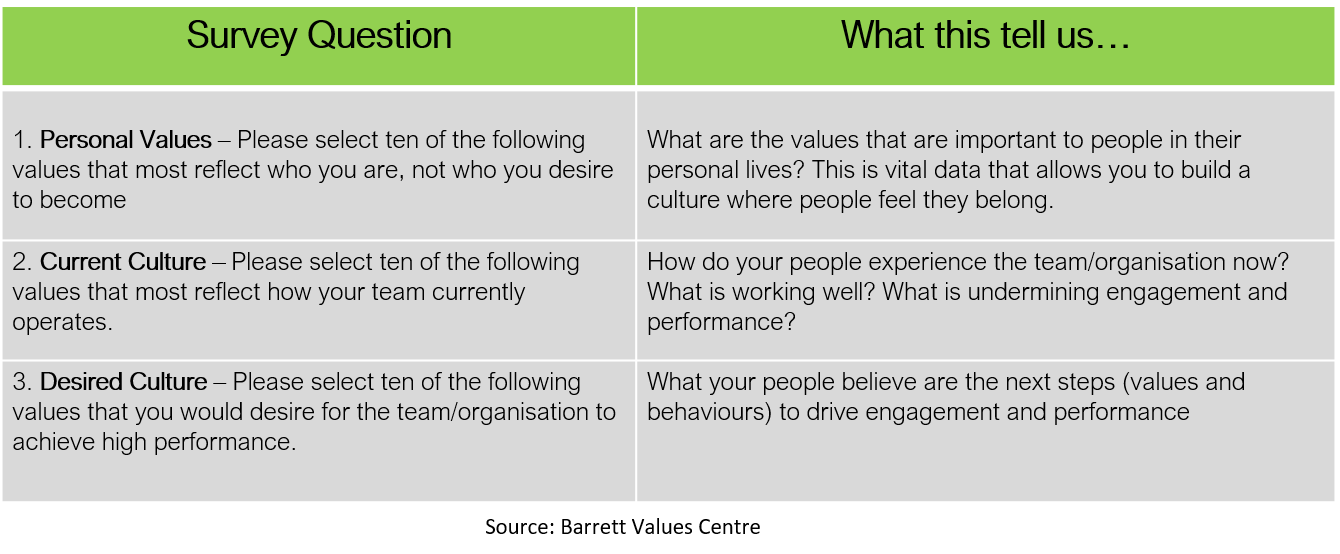
The assessment provides the basis for a different conversation – one where real connection happens and healthy change becomes possible. This provides the context for the broader team exploration which includes the following themes:
- ‘Why do we exist?’ or ‘What is our purpose?’
- How is our team culture contributing to the customer experience and the culture of the wider organisation?
- Given what I now know about myself and others, what does that mean in the context of how we operate as a team and the culture we want to create?
- What matters to us collectively as a group and how can we create a culture where we feel greater alignment?
- What is it about the way we operate that is hindering or helping the personal wellbeing of each of us?
- How are we fulfilling our role to deliver on the business strategy?
- Given what we now know, what are our goals and priorities?
The process enables the group to make choices about ‘the way we want to work together’ and ‘the way we want to be together’ and to take committed action to make that happen. This exercise often reveals ‘blockages’ that are preventing the team/organisation from being their best and identifies the key leverage points to harness the energy and build a healthy culture and thriving team.
The way the learning journey is facilitated and the skills that are practised during the team learning journey build connection, which in turn moves the organisation towards being more human. Where meaningful conversation and deep listening occurs, change happens.
“There is no power for change greater than a community discussing what it cares about” (Margaret Wheatley – Turning to One Another)
In Part 3 I explore Connect to Our Reality and Connect to our Learning.
In this series of blogs posts of I have been exploring the different aspects of ‘connection’ that exist at the heart of a human organisation. In Part 1 I looked at the individual perspective, ‘Connect to Me’ and in Part 2 at the team- or organisation-level perspective, ‘Connect to Us’.
These derive from the model presented here, which is adapted from the Barrett Values Centre ‘Get Connected’ model and which I use in my work as a road map to simplify some of the complexity and multi-faceted considerations that exist when navigating cultural change.

In this post we will explore the third cornerstone, ‘Connect to Our Reality’ and the one that brings it all together, ‘Connect to our Learning’
Connect to Our Reality
In this cornerstone of the ‘Get connected’ model, our focus is on understanding the team, the organisation and the wider environment as a whole and dynamic ‘system’ in the context of:
- Business vision and purpose
- Business strategy
- Business performance
- The customer experiences
- Internal environment (organisation culture and employee experience) and
- External environment (competitors, political, economic, social, legislative etc).
Thinking systemically and holistically and understanding dependencies and the broader context of the overall system is vital to creating a healthy, high-performing team culture.
Building connections means understanding, paradoxically, that everything is already connected. Recognising the interconnectedness of different systems – for instance a team in the context of a business unit, a business unit in the context of an organisation, an organisation in the context of a parent organisation and the external landscape – makes sure that the context for transforming the team culture is aligned.
I once worked with some individual faculties which each formed part of a large educational institution. The team within each faculty had its own subculture, as did every other team. And then there was an overall culture that existed across the organisation. This is quite normal, of course. You’ll see a form of it in every large organisation. The challenge when working with just one faculty is that while you can work on changing the ‘local’ culture, you can’t change the culture at an organisational level. But you can’t ignore that broader context either.
By understanding and accepting the ‘connection to our reality’ we are better able to identify the boundaries in which we operate, which strengthens the team focus and resolve towards their desired culture as an expression of that group of people.
Connect to Our Learning
“If you want a harvest in a year, grow a crop…
If you want a harvest in ten years, grow a tree…
If you want a harvest that will last for a life time, grow people.” -Chinese Proverb
‘Connect to Our Learning’ sits front and centre in our Get Connected model for building team culture and that is rightly where it belongs. Culture transformation doesn’t happen without engaging every single employee on a learning journey to develop self-awareness and the practical skills and behaviours they need to increase their self-mastery, to learn to manage their behavioural triggers, to see different perspectives and to enact self-leadership.
In a healthy team culture, ‘everyone is a leader’. Leadership is a mindset and a behaviour that applies to everyone, not just the anointed few. People are responsible for playing a role in driving their own learning and development and the organisation is responsible for providing the learning opportunities that create engaged employees and healthy, high performing culture.
Our Get Connected approach to building team culture is a learning process designed to ignite new awareness about ‘who we are’ and ‘how we show up’ and to bring to the surface the visible and invisible factors driving engagement and performance. This process is deeply transformational as we delve into what is occurring below the surface and uncover the assumptions that are held about the impact of the different dynamics across the eco-system and on individual and organisational performance and well-being.
This post takes the reader on a journey into an art therapy experience that I facilitated for colleagues and it shows the power of art process in surfacing unconscious parts of ourselves to enable personal insight and empowered action.
I recently facilitated a workshop for a group of leadership development professionals. This is not necessarily an easy thing to do, effectively facilitating an experience for your peers. However in this case I knew I would be introducing these participants to something that was new to them: the use of art therapy to get guidance on a personal issue or challenge.
I started by leading the group through a meditation and breath awareness exercise. Even those who have not done much meditation can find such an exercise helps them to relax and release the pressures of the day.
The next step was to take them through something an art therapy exercise involving the creation of a ‘two-handed closed eyes scribble drawing’.
Most of us, especially those working in business- or management-type roles, have long lost the ability to create art. As kids we all did it, but as we grew up we developed an inner critic that caused us to stop even picking up a pencil or paint brush. We are simply paralysed by the thought that the end result of our work won’t be ‘good’.
In art therapy, the inner critic is circumvented by making the process the experience rather than the end product.
As I had the participants take up their pastels, beautiful music filled the room, helping to create the ‘container’: a safe space with clear boundaries. This is what allows the magic to unfold.
The exercise involves spontaneous drawing with, as the name suggests, both hands and closed eyes. The imagery that arrives is a gift from our inner knowing. We are recreating a part of ourselves on the page in front of us. As we open our eyes and engage with this, something shifts within us. It may sound far fetched but I have seen the outcome too many times to believe otherwise.
One of the participants during this experience shared that he had had many months of lacking direction and focus and generally feeling stuck in his work and life. This despite the fact that he himself was a leadership expert, with many development tools in his kit and high levels of personal awareness.
Of course, it wasn’t an unusual situation. Many people in our world have had a similar experience of having a grating sense that something is not right, something is unresolved. Perhaps you have too?
This spontaneous scribbling process relaxed this man’s conscious mind. He found himself surprised that the drawing he created brought to the surface imagery that informed him about what he had been experiencing and that previously he had not been able to recognise. It was as if a cloud had lifted. As he engaged with the image, he felt a sense of relief, an unlocking. He later titled his drawing ‘Stuck in the mud’.
From an art therapy perspective, this man’s response was his unconscious communicating with him through his drawing. It provided him with a newfound clarity about what action he needed to take.
Since I developed my interest in art therapy, I’ve seen how something magical can happen when we bring our inner imagery to the surface in this way, having it on a page in front of us. It creates some space between our ‘self’ and that part of us that is feeling stuck or uneasy. We move from overwhelm and a state of feeling frozen into a new world of possibility. The ‘stuckness’ becomes just a part of us, not all of us, and that makes it feel more manageable. There is space around it:
I feel stuck
Something is stuck
I’m sensing something is stuck
From there we are once again empowered and can take committed action from that place of deep knowing.
This particular client was eternally grateful for having been given access to a new way to connect with his inner knowing from which he could emerge out the other side with clear, tangible and empowered action. This is what this client shared after the experience (reproduced here with his kind permission)
“In the first exercise I saw it in a split second – stuck in mud! And then to draw with both hands; firstly symmetrically and then, as it went on, more and more randomly.And then to see within what I called Mr. Magoo and the freedom that was within. It blew me away!!! This process provided me with the ability to see inside myself and see that I was stuck and to come up with something ( Mr. Magoo) that has given me freedom and liberation.” – Evolving Leaders Client
Art process can change lives. It takes us beneath the surface of the story, the concept the idea, the stress-producing thoughts to access and give voice to our inner knowing: the things we know about ourselves but just can’t recognise – the things that just aren’t revealed to us in conventional personal and leadership development experiences.
This is why I believe art therapy has an important role to play in this next era of leadership development.
Interested in having a personal experience of art therapy? Evolving Leaders incorporates art therapy experiences into Urban Retreats for Teams, Managing Stress with Meditation Program and Team Culture and Wellbeing Development.


